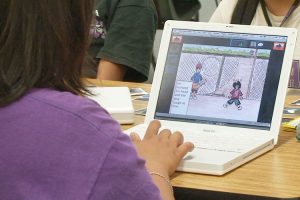ACE for Teachers: Kona Waena TeenACE

Project Dates: 2005 – 2006
Funded by: Department of Health and Human Services; Administration for Community Living; Administration on Disabilities; Administration for Children and Families; US Health Resources and Services Administration; National Institutes of Health; Office of Special Education and Rehabilitative Services
About
Across the US, the least literate have the least income. Some Hawaii public school students (esp. those with disabilities, poverty incomes, or English language learners) find themselves more likely to miss out on opportunities leading to success at school and in the workplace. Teachers need specific literacy strategies to bridge the existing divide. Konawaena TeenACE seeks to enhance instructional practices and boost teen literacy. This 1 year project will provide at least 9 teachers and 14 paraprofessionals with technology and project-based literacy strategies, and improve the literacy of teens (80 in special ed) who are 2+ years below grade level.
Goals include:
- IMPROVE SELF-EFFICACY AND SELF-SUFFICIENCY OF TEACHERS AND STUDENTS. Teachers and educational assistants (EAs) have knowledge in academic subjects and will gain skills to integrate computers and technology into their teaching. They will be introduced to the family of ACE Literacy program, including math, and to Video Futures for skills needed to succeed in school. (ACE = Actual Community Empowerment).
- IMPROVE PERFORMANCE OF YOUTH IN SPECIAL EDUCATION BY BOOSTING THE MOST-NEEDED LITERACY SKILLS AND CREATING POSITIVE LEARNING EXPERIENCES. Using the TEENACE LITERACY program and IntelliTools software, youth will read and write their own stories, record them on computer CDs, present them to youth children, and improve their literacy level (1-3 grade levels).
- CREATE POSITIVE LEARNING EXPERIENCES FOR TEENS THROUGH NEW METHODS. We will support teachers in other methods of their choice, based on principles of feedforward, the 90:10 rule, and project-based learning. Teachers will select programs that incorporate these principles, from an available menu.
- PROVIDE ACCOUNTABILITY THROUGH DATA. We will systematically assess the professional development of teachers and EAs. School staff will provide data on outcomes of their students, related to literacy acquisition and other aspects of school engagement and performance. We will disseminate findings to contribute to knowledge of theories, and implementation of more enjoyable and effective teaching and learning.
Outcome 1: ACE for teachers was developed to address the growing needs of professional development in the areas of: projected-based learning, student-directed learning strategies, ways to integrate multimedia technology into literacy instructions. A survey of the participating teachers at a school on the Big Island of Hawaii showed: 83% of those survey had either no or some knowledge of project-based learning; 83% of those surveyed had either no or some knowledge of student-directed learning strategies, 100% thought they had no or some knowledge of how to integrate multimedia technology with literacy learning. Student participants: 34 students 13-18 years in age, grade range 9th-13th, most used English as primary language at home, except 3 speaking a Filipino dialect or Spanish.
Outcome 2: First Cohort Outcomes: student’s writing ability improved significantly as measured by Pre and Post Scores on the Hawaii State Achievement Rubric (p=.03). Low performing students did well. Better students showed little or no improvement. (chart) TeenACE, as is, does well with Special Education students with very low performance in writing. Other studies have shown excellent gains with a range of abilities. We have ongoing research for further improvements.


